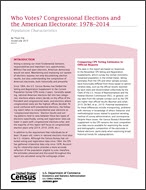Who Votes? Congressional Elections and the American Electorate: 1978–2014
Who Votes? Congressional Elections and the American Electorate: 1978–2014
Introduction
Voting is among our most fundamental domestic responsibilities and important civic opportunities. Without free and open elections, American democracy would not exist. Maintaining and improving our system of elections requires not only documenting election results, but also understanding the composition of America’s electorate, both historically and presently.
Since 1964, the U.S. Census Bureau has fielded the Voting and Registration Supplement to the Current Population Survey (CPS) every 2 years. Generally speaking, national American elections fall into two categories: elections where voters decide on the office of the President and congressional seats, and elections where congressional seats are the highest offices decided. To avoid confusion with presidential elections, the following report refers to nonpresidential year elections as “congressional elections.” Election results and voting patterns tend to vary between these two types of elections (specifically, voting and registration rates are lower in years with congressional elections only), and the majority of this report will focus on congressional election years only (2014, 2010, 2006, etc.).
In addition to the requirement that individuals be at least 18 years old, voters in national elections must also be U.S. citizens. Although the Census Bureau has collected voting and registration data since 1964, the CPS has gathered citizenship data only since 1978. Accounting for citizenship status provides a more accurate reflection of the population eligible to vote; therefore, the estimates presented and discussed throughout this report are calculated using the voting-age citizen population and go back as far as 1978.1,2 Readers interested in earlier years can utilize historical CPS voting estimates calculated regardless of citizenship status.
This report’s first section, “Historical Turnout in Congressional Elections, 1978–2014,” presents reported turnout rates, both overall and by race, Hispanic origin, and age, for each congressional election year from 1978 to the most recent election held in 2014.3
The second section, “Composition of the Electorate in Recent Elections, 2004–2014,” presents breakdowns of the voting populations in the last three congressional and presidential election cycles, with a focus on race, Hispanic origin, and age. Data are presented for both presidential and congressional election years, primarily to determine whether there have been electoral composition changes depending on the type of election.
The third section, “A Closer Look at Race, Hispanic Origin, and Age,” looks at how voter turnout intersects with demographic characteristics in an effort to better understand the dynamics of recent congressional electorates. By comparing a subpopulation’s share of the voting population to their share of the eligible population, an assessment can be made concerning how a given subpopulation has participated in the 2006, 2010, and 2014 congressional elections.
The report’s final section, “Traditional and Alternative Methods of Voting,” presents results related to voters and their reported method of casting ballots, specifically whether they voted early in person or through the mail. These questions were first asked in the 1996 CPS, and results are presented for the period of 1996–2014. In this section, data are once again included for both presidential and congressional election years, primarily to better understand how voting methods vary between different types of elections.
__________
1 From 1978 to 1992, citizenship status was asked about in the CPS Voting and Registration Supplement. Beginning in 1994, the basic CPS included a question about citizenship status, meaning that the supplement no longer needed to ask about this topic.
2 Removing noncitizens from the voting eligible population increases voting rates, as the population base for calculating the rates becomes smaller, while the number of people who report voting does not change.
3 Federal surveys now give respondents the option of reporting more than one race. Therefore, two basic ways of defining a race group are possible. A group such as Asian may be defined as those who reported Asian and no other race (the race-alone or single-race concept) or as those who reported Asian regardless of whether they also reported another race (the race-alone or in-combination concept). This report shows data using the first approach (race alone). Use of the single-race population does not imply that it is the preferred method of presenting or analyzing data. For further information, see the 2010 Census Overview of Race and Hispanic Origin: 2010 (C2010BR-02).
Table 1
Table 2
Table 3
Table 4a
Table 4b
Table 4c
Table 5
Table 6
Table 7
Table 8
Table 9
Table 10
Table 11
Table 12
Table 13
Others in Series
Publication
Publication
Publication








